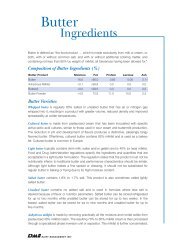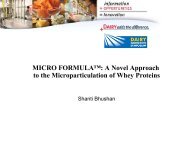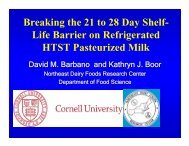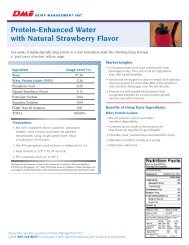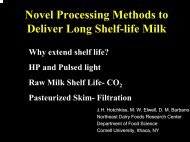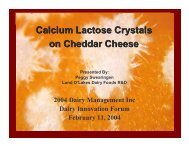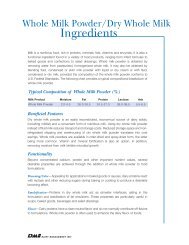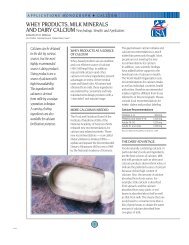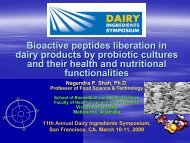Whey Protein Characteristics - InnovateWithDairy.com
Whey Protein Characteristics - InnovateWithDairy.com
Whey Protein Characteristics - InnovateWithDairy.com
Create successful ePaper yourself
Turn your PDF publications into a flip-book with our unique Google optimized e-Paper software.
Most of the foods we consume are between pH 3 and 7. At pH 3, β-lg has a very high net positive charge, which means the<br />
proteins in the solution will have a lot of repulsive forces between them. These repulsive forces will inhibit interactions between<br />
proteins, even when heat is applied — so heat stability and clarity (lack of turbidity) even at protein concentrations of 7 percent<br />
protein is high. Once the pH is increased to 4, the net charge is decreased, as is the repulsion. The whey protein solution will<br />
now increase in turbidity, even without heating, due to the attraction between proteins. When heat is applied at temperatures<br />
higher than the denaturation temperature of 78 C β-lg, protein aggregation and precipitation will occur unless some other<br />
ingredients are added to improve the heat stability of the proteins. At pH 5.2, the isoelectric point, the protein has a net charge<br />
of 0 and the potential for protein-protein interaction is at its highest point. The protein will precipitate out of solution readily at<br />
this pH. As the pH is increased up to pH 7, the net charge on the protein will shift to negative, but the net negative charge at<br />
pH 7 is similar to the net positive charge at pH 4.2. 8<br />
Commercial Heat-stable Ingredients<br />
Techniques exist today to improve the heat stability of whey protein ingredients. Some of these techniques are used in<br />
<strong>com</strong>mercial ingredients. Examples include protein hydrolysis, modifying the mineral <strong>com</strong>position or adding mineral chelators.<br />
These techniques and other new research are discussed in the next section.<br />
New Research and Methods to Improve Heat Stability<br />
in Commercial Ingredients of the Future<br />
Recent research funded by the Dairy Research Institute has focused on improving the heat stability of whey proteins to<br />
increase their use in an even wider range of food products. Researchers have chosen various approaches to improve<br />
whey protein heat stability including: controlling the size of protein aggregates through sugar addition, enzymatic crosslinking,<br />
mineral chelation and ultrasonication; or modifying whey protein to prevent aggregation through molecular<br />
chaperones, enzyme hydrolysis, electrostatic repulsion, conjugation with carbohydrates and protein encapsulation.<br />
Controlling the Size of <strong>Protein</strong> Aggregates<br />
Sugar Addition<br />
Several researchers have studied the relationship between sugar addition and heat stability of whey protein ingredients.<br />
Sucrose addition was found to increase gelation temperature and gel strength of WPI and bovine serum albumin. 9,10,11,12,13<br />
Adding glycerol improved heat stability of WPI and decreased turbidity and protein gelation. 10,14 The addition of sorbitol<br />
also increased thermal denaturation temperatures of WPI and was more effective than glycol. No gelation occurred after<br />
heating a 10 percent β-lg solution with the addition of 0 to 55 percent sorbitol at pH 7.0. 15 Many food applications contain<br />
sugars or sugar alcohols, and their presence can help to improve the heat stability of whey protein ingredients<br />
by preventing the formation of large aggregates and providing better clarity in applications such as beverages.<br />
8<br />
Personal <strong>com</strong>munication with Allen Foegeding.<br />
9<br />
Foegeding EA, Davis JP, Doucet D, McGuffey MK. Advances in modifying and understanding whey protein functionality. Trends Food Sci Technol. 2002;13:151-159.<br />
10<br />
Rich LM, Foegeding EA. Effects of sugars on whey protein isolate gelation. J Agric Food Chem. 2000;48(10):5046-5052.<br />
11<br />
Baier S, McClements DJ. Impact of preferential interactions on thermal stability and gelation of bovine serum albumin in aqueous sucrose solutions.<br />
J Agric Food Chem. 2001;49(5):2600-2608.<br />
12<br />
Baier SK, McClements DJ. Influence of cosolvent systems on the gelation mechanism of globular protein: Thermodynamic, kinetic, and structural aspects of globular protein<br />
gelation. Compr Rev Food Sci F. 2005;4(3):43-54.<br />
13<br />
Baier SK, McClements DJ. The effect of binary cosolvent systems (glycerol-sucrose mixtures) on the heat-induced gelation mechanism of bovine serum albumin. Int J Food Sci Technol.<br />
2006;41(2):189-199.<br />
14<br />
Kulmyrzaev A, Bryant C, McClements DJ. Influence of sucrose on the thermal denaturation, gelation, and emulsion stabilization of whey proteins.<br />
J Agric Food Chem. 2000;48:1593-1597.<br />
15<br />
Chanasattru W, Decker EA, McClements DJ. Modulation of thermal stability and heat-induced gelation of β-lactoglobulin by high glycerol and sorbitol levels. Food Chem.<br />
2007;103:512-520.<br />
e3.11.1 3



